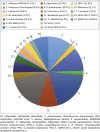Respiratory pathogens detected in specimens collected for COVID-19 surveillance in Zambia
- PMID: 40083467
- PMCID: PMC11905193
- DOI: 10.4102/jphia.v16i1.684
Respiratory pathogens detected in specimens collected for COVID-19 surveillance in Zambia
Abstract
Background: In Zambia, knowledge on the landscape of respiratory pathogens that circulated during the coronavirus disease 2019 (COVID-19) pandemic is limited.
Aim: This study investigated respiratory pathogens that circulated in Zambia during the COVID-19 pandemic.
Setting: Nasopharyngeal specimens collected between July 2020 and July 2021 for COVID-19 testing in hospitals, ports of entry, persons seeking certificates for international travel and in communities were used.
Methods: Proportional age-stratified sampling was used to select 128 specimens. The samples were screened for 33 other respiratory pathogens using the Fast Track Diagnostics multiplex molecular assay.
Results: Overall, 71.1% (n = 91/128) tested positive for at least one respiratory pathogen. Bacterial respiratory pathogens were more predominant (70.3%, n = 90/128) than viral (51.6%, n = 66/128). Staphylococcus aureus was the most prevalent, detected in 22.7% (n = 29/128). The prevalence of influenza was 13.3% (n = 17/128). Rhinovirus had a prevalence of 3.1% (n = 4/128), while it was 10.1% (n = 13/128) for adenovirus. Children, adolescents and the elderly accounted for most influenza-positive specimens, 76.5% (n = 13/17), while 100% (n = 3/3) of specimens positive for Moraxella catarrhalis were from children. All specimens testing positive for Haemophilus influenzae, 100% (n = 5/5) were from children and adolescents. Co-infections were detected in 57.1% (n = 52/91) of specimens testing positive for at least one pathogen.
Conclusion: Bacterial respiratory pathogens appeared to predominate circulation during the COVID-19 pandemic period.
Contribution: Bacterial respiratory pathogens should not be neglected when implementing public health mitigation measures.
Keywords: COVID-19; Zambia; co-infections; respiratory pathogens; surveillance.
© 2025. The Authors.
Conflict of interest statement
The authors declare that they have no financial or personal relationships that may have inappropriately influenced them in writing this article.
Figures
References
-
- World Health Organization . Non-pharmaceutical public health measures for mitigating the risk and impact of epidemic and pandemic influenza [homepage on the Internet]. 2019. [cited 2024 May 24]. Available from: http://apps.who.int/iris
LinkOut - more resources
Full Text Sources


